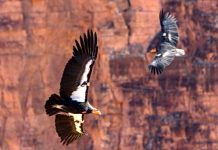SALT LAKE CITY, Utah, Nov. 4, 2021 (Gephardt Daily) — Utah Division of Wildlife Resources conservation officers are reminding the public to not remove desert tortoises from the wild and to ensure that out-of-state tortoises have the proper certification when accompanying their owners to the state.
Officers have seen an uptick in tortoise theft-related cases, investigating nine so far this year, said a news release.
The majority of the cases occurred this summer in Washington County — the native range of the Mojave desert tortoise in Utah — while two of the cases took place in the central part of the state.
In Utah, it is illegal to collect or remove desert tortoises from the wild, the news release said. The Mojave desert tortoise, located north and west of the Colorado River in Arizona, Utah, Nevada and California, was listed as threatened under the Endangered Species Act in 1990. As such, desert tortoises are protected under federal and state laws.
It is also illegal to release captive tortoises back into the wild or to transport them into Utah without the proper certifications.
“Removing tortoises from the wild can harm wild populations by reducing their ability to reproduce and sustain themselves on the landscape,” DWR Wildlife Biologist Ann McLuckie said. “Tortoises that are removed from the wild cannot be released back into the wild, due to a risk of introducing diseases, especially if they’ve been kept in a home with other animals. They are susceptible to a density-dependent disease called upper respiratory tract disease, which presents like pneumonia.”
If a desert tortoise owner moves from another state into Utah, they must apply for the proper certifications in order to bring their tortoise with them; otherwise, they must return the tortoise to an approved adoption facility within their previous state.
“Unfortunately, it is fairly common that we have to seize tortoises either brought into the state illegally or that are illegally removed from the wild,” DWR Lt. Paul Washburn said. “All the tortoises from these recent cases were seized and will be placed into our tortoise adoption program.”
The Utah Desert Tortoise Adoption Program began in the 1990s, after tortoises were placed on the endangered species list. If you are interested in adopting a tortoise, you should do the following:
- Email [email protected] to inquire about tortoises available for adoption.
- Design a safe outdoor and indoor environment for a tortoise, following the DWR guidelines.
- Apply for a certificate of registration for $75 to legally adopt a desert tortoise.
- Be aware that tortoises can live up to 80 years, and note that you are responsible for all veterinarian costs.
In Utah, the majority of tortoises reside in the Red Cliffs Desert Reserve where there are roughly 2,000 adult tortoises.
“If you see a desert tortoise when you are hiking, watch it from a distance and leave it alone so other people can enjoy it as well,” McLuckie said.
“Tortoises are cute, but they can live for decades, may outgrow their artificial habitats and can dig themselves out of — or simply escape — most backyards. Please let them stay wild and don’t add to the decline of their population.”






